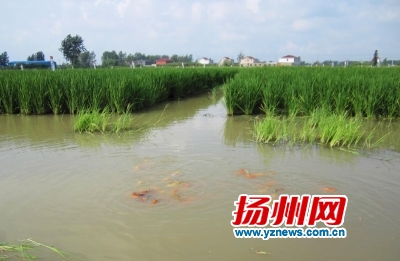Raise ducks, lobsters and koi in rice fields

There are koi in the rice fields.
The technician is looking at the pests in the trap lamp.
A piece of purple rice seedling.
The reporter learned from the Institute of Agricultural Sciences in Lixiahe area yesterday that the experimental base of Gaoyou sending Bridge is currently trying a "three-dimensional green prevention and control" technology, which does not apply chemical fertilizers and pesticides, but through the creation of a biologically diverse environment, combined with physical, physiological and biological methods to control rice, aquatic plants, diseases and insect pests. Among them, duck, koi and lobster play an important role.
Strange! Rice seedlings are colorful.
Approaching the experimental base of the Agricultural Science Institute at Gaoyou delivery Bridge, the rice seedlings here are not all green, but also lavender, dark purple and other colors; even if they are green, there are dark green, light green and other changes. Zhang Jiahong, head of the project, said that diversified rice is the basis of the "three-dimensional green prevention and control" technology. "many rice varieties have been planted in this experimental base, and different rice have different resistance to diseases, insect pests and grass pests. We hope to create a diversified environment in this way and make the ecology as balanced as possible."
Raise ducks, koi and lobsters in rice fields
The paddy fields of the experimental base are different from ordinary paddy fields. Some have duck sheds, and some have dug a deep and wide ditch next to them.
According to Zhang Jiahong, the rice field with duck sheds is a "rice-duck co-farming" model, with 30 ducks per mu. Ducks are omnivorous animals that eat both grass and insects. Rice fields dug deep ditches are divided into two models: "rice-shrimp co-cultivation" and "rice-fish co-cultivation". The former can raise at least 100 jin of shrimp per mu, while the latter can raise 100 fish per mu.
Tang Hejun, a technician at the experimental base, said that under the "rice-fish co-farming" model, at present, ornamental fish and brocade carps are cultivated in the water, and fish can eat not only aquatic plants, but also insects; in the "rice-shrimp co-farming" model, lobsters are all lobsters, and lobsters are omnivorous animals.
Insect control also depends on insect traps and sex attractants.
Yesterday, several workers were invited to the experimental base, and their main task was to clear weeds in the field. Tang Hejun said that under the mode of "co-cultivation of rice and shrimp" and "co-cultivation of rice and fish", some old grasses are very difficult to eat, so they need to be pulled out manually.
In addition, there are two auxiliary "weapons" in the rice fields-insect traps and sex attractants. Sex attractants release female pheromones to lure males to come and centrally destroy them, thus reducing the number of pests in the next generation. Zhang Jiahong said: in terms of rice yield, the output after the application of "three-dimensional green prevention and control" technology is 800 jin per mu. "although the yield is lower, because chemical fertilizers and pesticides are not used, the market price is much higher and the overall benefit is much better." Reporter Xiang Jiafu / Picture
- Prev

E-commerce training allows farmers to pull the net cable to run towards a well-off society
E-commerce training allows farmers to pull the net cable to run towards a well-off society
- Next

Haibei Prefecture: the Little Lamb supports the Big Industry
Haibei Prefecture: the Little Lamb supports the Big Industry
Related
- A course of planting techniques and methods on how to grow carrots
- How to plant the latest tulips?
- Is it better to pick tea in the morning or in the afternoon? When is the best time for tea to be picked? what is the third or fifth tea?
- Launch Yuanxiao Happy combination Haocha + Tea Yuan healthy Taste
- Penghu Tourism "Fireworks 20 Parade with You"
- 2022 West Lake Happiness holds "Digital Revitalization Voucher" and draws iphone13 and laptop.
- Banqiao Fuzhou social houses are designed to change start-up combined with police elimination to create a safe and livable environment
- The convenient measure of "mechanical weeding" in Xinbei has been abused and the Agriculture Bureau has imposed heavy penalties on the illegal land consolidation.
- Changgeng University Joins Hands with Four Memory Factories to Rescue Memory Talent Shortage
- The list of Taiwan's top 100 MVP managers is listed by the Director-General of the Farmers' Association of Sanxia District.

